
Jay60p
-
Posts
169 -
Joined
-
Last visited
Content Type
Profiles
Forums
Articles
Posts posted by Jay60p
-
-
On 5/7/2020 at 3:24 PM, Jay60p said:
In FCP X you can see the difference between what's happening with SmoothCam vs. InertiaCam after analysis..
I just noticed you have to have FCP X viewer in "better performance" mode, otherwise the edges are cropped in playback
and you don't see the pre-cropped movements of the frame edges.
And for what it's worth, I found the "neck strap" method of hand holding during a walk helps reduce shake.
That is holding the camera in front of you far enough for the strap to be tight around the back of your neck
and viewing the shot on the LCD as you walk.
-
11 hours ago, Anaconda_ said:
My camera and Pi has arrived and I'm happy to say it's going to fit very nicely in a (broken and unusable) Bolex B8 - by my calculations, the sensor size is similar to that of 8mm film, so I'm planning on taking off the C-mount from the sensor and placing to look through the D-mount lenses on the camera. Which will also let me hang onto the turret system.
As my camera is already broken, I'm going to have to gut it, so it's essentially the most hipster RPi case around, but I'm fine with that. There's tonnes of room for a power bank etc. to keep everything nicely held inside. Can possibly keep the mechanism too so I can make cool noises while filming.
This Cinetinker blog shows how to open your Bolex and take out the insides for service, lots of cool photos of intricate parts & gears. (maybe you'll see what is broken and will fix it instead!)
http://cinetinker.blogspot.com/2013/01/
"Although the following service procedure is done on a D8L (more or less a D8LA without the rewind facility), all of the pocket cameras used basically the same internal mechanisms, so portions of this procedure can also be used on them. This includes the B8, C8 and D8 variants and the zoom reflex models P1, P2 and P3."
-
I just tried some more walking and running at 10mm with the 10-24mm zoom, with OIS on to help.
In FCP X you can see the difference between what's happening with SmoothCam vs. InertiaCam after analysis
by reducing the scale of the frame (I did 50%) and then playing the clip in slow motion (holding down K + L keys).
In SmoothCam the edges of the frame move up, down, sidways and rotate slightly as it compensates for the
walking motion in the shot. But the frame remains a rectangle, does not distort "out of square".
But in InertiaCam the frame does move out of square with edges stretching in or outwards as the clip plays.
This may be why a 10mm extreme wide angle will stabilize better with less warp in software than in the X-T4 IBIS.
Anyway, my running test failed miserably, that's just too much violent movement for the Software to fix!
Long ago I briefly considered a gimbal but realized the way I work, I'd rarely actually go to the time and trouble of
setting up & balancing the thing. Besides I don't do much running, I more of a biker.
13 hours ago, kye said:One thing that caught my eye recently was the idea of using a short SS, stabilising in post, then applying a fake motion blur to emulate a 180-shutter after the stabilisation has been done.
8 hours ago, gt3rs said:I'm experimenting a bit like this using high SS and adding motion blur back as I have sometime the requirement to have photo and video at the same time.
Are you using 24 or 30fps and what motion blur solution works for you?
-
Yes, you need to use higher shutter speeds. My walking shot I'm referring to was shot at 4k 60p at 1/125th sec,
so there is no overly blurred frames as I was taking steps. Plus there is more for the stabilizer to work with
at 60fps compared to 24 or 30.
But even beyond that, the FCP X stabilizer must be doing more than what the merely mechanical IBIS
is doing when shifting axes. If I set it for "SmoothCam" motion, I do get some of the corner wobbles with
my 10mm wide angle, but setting it to "InertiaCam" motion reduces that wobble distortion. Then pulling the
amount down from the default "1" amount to say, "0.5" reduces the stabilization & the distortion & cropping
but still gives a major improvement over no stabilization, and at that point I am quite happy with it.
In fact I usually find the default "1" to be overkill.
-
There is a lot of discussion about the “wobbliness” with the new IBIS in the X-T4.
What about software stabilization?
(No doubt this has been discussed before, I just can't seem to find it)It seems Premiere, After FX, Resolve, FCP X all use the same basic functions
such as translation, rotation, scaling, cropping etc. and have the advantage
of selecting kinds of & amounts of stabilization after the fact.Walking shots with a 10mm wide angle on the X-T3 are much improved with
much less “wobbliness” distortion than I see in the IBIS youtube videos, with
an acceptable amount of cropping.“Acceptable” is subjective and I’m sure a lot of people avoid post production stabilization
completely. But the more I play with it the more I like it for certain kinds of shots.Example: a zoom shot, on a locked tripod with a manual lens. Trying to do an extremely
slow zoom by turning the ring by hand is difficult to do at constant speed throughout.
Turn on stabilization and an unsteady manual zoom runs as smooth
as a camcorder’s motorized zoom, with ease in and out added at the start and end.
And in my testing the cropping is almost nothing.Any other suggestions, opinions?
-
5 hours ago, heart0less said:
That's the question I was asking myself. You can't really know that unless you buy it.
And when you do and it turns out that it isn't any better, then you are screwed, since in many cases it's impossible to return it - I get all my adapters from eBay or AliExpress, because we have no B&H in Poland (nor any close equivalents) and those kind of things are really tricky to get.
I guess I prefer to correct them using DIY methods rather than order some different copy from other brands and have no guarantee they would work.
The good news is that these DIY methods are easy, I'm set now and don't need to try the Pro adapters.
If the adapters were too long instead of short, then we'd really be screwed!
Here's my final results with my 35mm SLR zoom lenses & adapters I use for video (your results may differ)...
Nikkor AF 28-85mm f/3.5-4.5 on Fotodiox NIK-FX - parfocal, no adjustment needed.
Nikkor AF 28-85mm f/3.5-4.5 on Fotodiox NIK(G)-FX - needs extension for parfocality.
Canon FD 35-70 f4, and Canon FD 70-210 f4 on Fotasy FD-FX - parfocal, no adjustment needed.
SMC Pentax-AF 100-300 f/4.5-5.6 on Fotodiox PK(A)-FX - needs extension for parfocality.
-
Does the free version of Resolve do 4K60p now? Last time I looked it didn't so never tried it.
On my Mac mini (i5) I use FCP and it always plays HEVC 4k60p smoothly at the viewer's
"better performance" setting. Maybe due to the mini's T2 chip acceleration for H265.
I expect FCP will always be optimized for performance on a Mac sooner than the non-Apple apps.
But definitely try both! You never know what is going to work best on any particular machine.
And the time lines are very different, you should try both to see what you prefer.
-
I found the same problem with my SMC Pentax-FA 100-300 and the Fotodiox PK(A)-FX adapter.
Symptoms are focusing past infinity, and shifting focus distance farther when zoomed back to wide angle.
I fixed that adapter the same way, but that needed more than twice as much extension (18 thousands of an inch).
The lens is now parfocal. I can see why Fotodiox would want to err on the short side with these adapters since
prime lenses aren't much affected as long as they reach infinity. Zooms need more accuracy for parfocality.
Maybe the more expensive "pro" Fotodiox are more accurate?
-
P.S. If my X-T3 shots don't look so hot, they were blow-ups from the full frame's view:
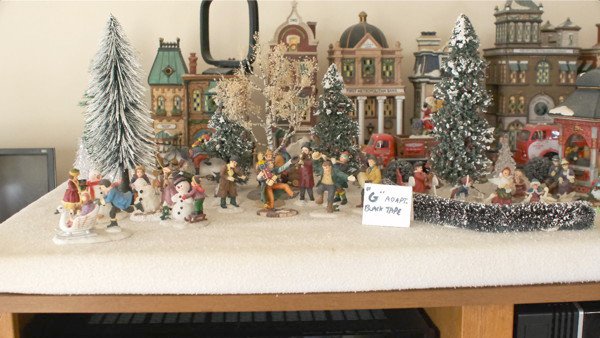
and shot in available light in UHD at 60p but only 100mb/s, at ISO 10,000 since it was a quick and dirty lens test.
Didn't know I'd be putting this online.
-
Thanks, that is good info. I also have M42 and Pentax and Nikon.
Too bad it doesn't take Canon FD.
The only thing is, that means having two adapters on a lens instead of one,
so I would have twice the chance of back focus error.
I suppose I could buy both and see which maintain best parfocality with the Nikon zooms I have,
and return the other. B&H in New York is very good about returns within 30 days.
Will keep this in mind.
-
10 hours ago, heart0less said:
In the end, I was able to correct the backfocus with my speedbooster (rotating the rear glass element did it), so at least it keeps its focus when I use it with Lens Turbo II.
I've been considering the Lens Turbo II, Nikon F to Fuji X.
Which one do you use? And how did you rotate the rear element? I assume that is not an "official" feature.
-
Here is a Nikkor AF 28-85mm f/3.5-4.5 SLR zoom lens mounted on my X-T3,
with the basic Fotodiox adapter for Nikon F.
The lens focus is parfocal from 28mm to 85mm, with a smooth zoom ring, great for video zooms: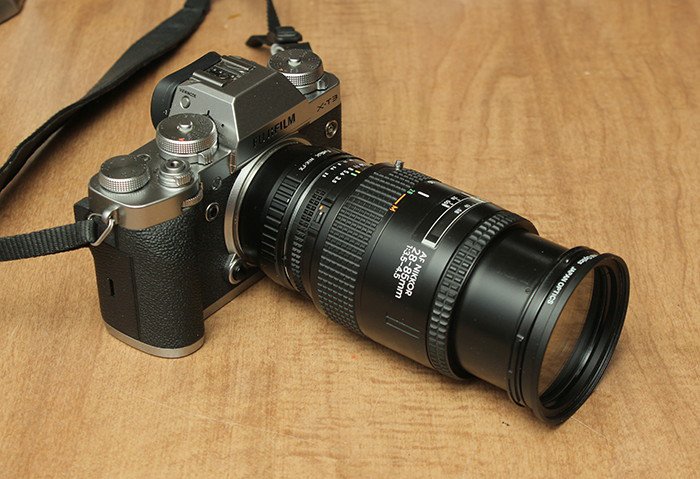
So I was surprised to find weeks later that it suddenly was not
holding its focus, it was focusing farther at wide angle (??)At 85mm, focused manually (a screen grab cropped into the video):

Then zoomed out to 28mm, the focus shifted behind the subject:

Eventually I realized that I was using a different Fotodiox Nikon F adapter this time,
and the only difference was an aperture control ring built in for G lenses: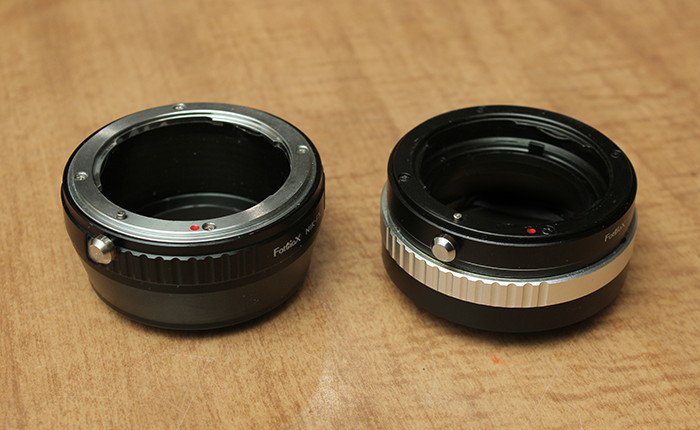
I compared the thickness of the two adapters with a small C clamp.
The G adapter was a hair shorter than the basic adapter,
and the G adapter had the lens focus going too far past infinity.
So I decided to extend the G adapter’s length a slight bit.
I removed the back of the adapter by removing four screws,
and I added a thin layer of tape to extend the adapter’s overall length: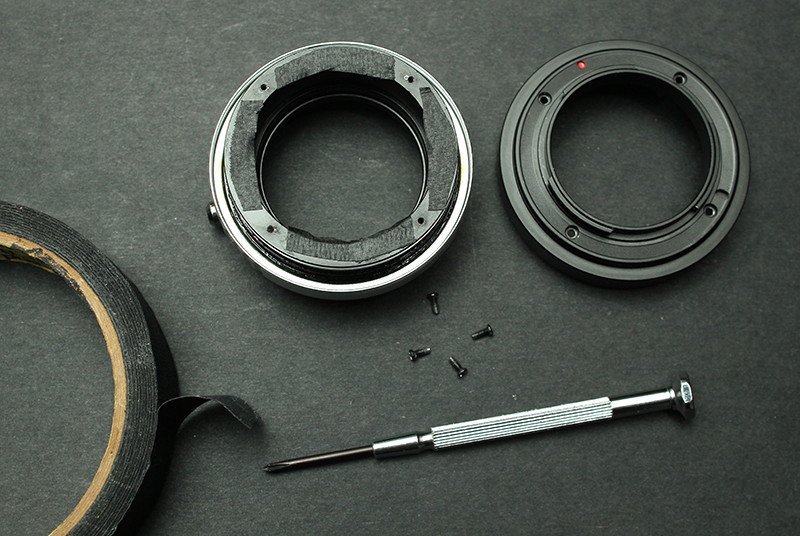
Finding the right thickness of tape was trial and error.
Thin cardboard, too thick. Duct tape, too thick. Black masking tape worked.Now after zooming out it is back in focus:

So a mounting error of the thickness of masking tape threw off the zoom’s parfocality!
How thick was this tape? I have an old caliper from my grandfather, and it measures
in 1/1,000 inch increments. (But not wide enough to measure the Nikon adapters):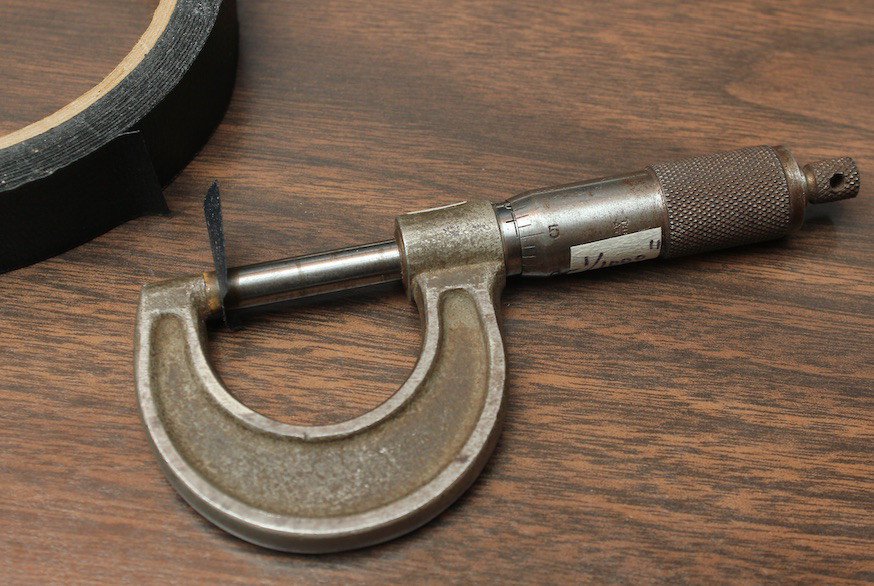
The masking tape is seven thousandths of an inch thick. That's about a sixth of a millimeter.
The moral of the story: if your vintage zoom lens adapted to your mirrorless camera
appears not parfocal for video, try another brand of adapter, especially if it has infinity focus
adjustments. Apparently all it takes is a few thousandths of an inch to throw it off. -
Hello from the USA!
Current camera Fuji X-T3, with my latest lens
acquisition AF-n Nikkor 28-85mm f/3.5-4.5,
And DIY lens support rails built with old chem lab hardware.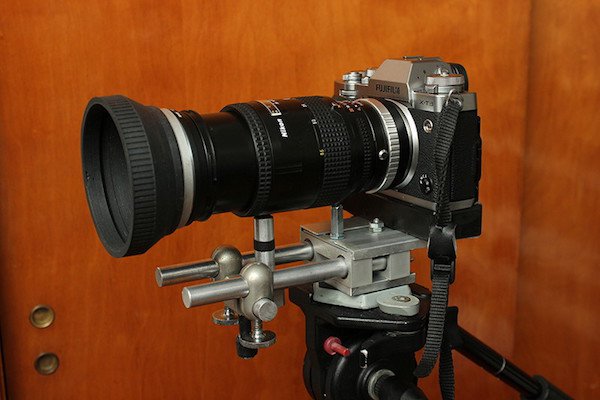
I’m married with two boys in high school, retired.
Favorite music: classical (Bach & Beethoven),
and British ’70’s rock (Yes, ELP, Who, Tull, etc)Hobbies: playing an old grand piano, Hammond M3, Minimoog, Prophet,
Rhodes 73, Peavey DPM-C8.
Recording Multi-track (used to be Tascam 38, now Macintosh).
Lionel train layout & miniature village,
Old movie film production equipment & projectors in 16 & 35mm,
Tinkering with various hardware & old equipment parts to do something new.EOSHD coverage: looking forward to new tips & tricks for mirrorless video,
best vintage lenses, and comparisons of the new cameras.I found EOSHD early 2019 after getting the Fuji X-T3.
My 1st DSLR was Fuji S1 Pro (great color! https://***URL removed***/reviews/fujis1pro,
pictured with the same Nikon lens I used.) Next was the Canon T2i.
But I did not use these for video and never looked at photography forums online.
But Fuji X-T3 is a completely different animal!- heart0less, BTM_Pix, Adept and 6 others
-
 9
9
-
On 3/26/2020 at 11:49 AM, Jay60p said:
Stop motion animation:
Clay (Gumby, Wallace & Gromit).
Toy figures with armatures.
https://www.youtube.com/watch?v=Gg1KCyU1JEU
Lego blocks building themselves.
Drawing on paper (animate the progress of a piece of flat art)
Moving sand/small bits of stuff in patterns.
https://www.youtube.com/watch?v=578Xm6bgMdQOOPS! I grabbed these examples to fast, these Jan Svankmajer animations are too dark for inspiring
animations with the kids at home!
These are better:
https://www.youtube.com/watch?v=8FAt7ze-QLQ
https://www.youtube.com/watch?v=2BwUh7nbkyU
https://www.youtube.com/watch?v=qtpRMsDuH74
and one of my favorites, https://www.youtube.com/watch?v=hzvqmoPu2H4
As for clay, just grab a big lump and start twisting it into random shapes and see what happens!
-
A few video experiments to try at home:
Slow motion and reverse motion:
Water drops
Remote control toys (RC cars, helicopters, etc)
Collapsing constructions of blocks, toys, dominoes, etc…
Put on a gorilla suit and hit a pile of bones with a large femur.Stop motion animation:
Clay (Gumby, Wallace & Gromit).
Toy figures with armatures.
https://www.youtube.com/watch?v=Gg1KCyU1JEU
Lego blocks building themselves.
Drawing on paper (animate the progress of a piece of flat art)
Moving sand/small bits of stuff in patterns.
https://www.youtube.com/watch?v=578Xm6bgMdQBest to use a tripod, or a copy stand (I use an old enlarger stand),
unchanging light source, and a remote control to avoid touching
the camera.Timelapse, (cameras with interval recording)
Such as, watch a window’s sunlight move across a room,
ice cubes melting, traffic at intersections.I use vintage SLR lenses for stop motion & timelapse
since the apertures and focus
cannot be inadvertently changed by the camera.
To get the classic slow shutter blur for fast moving objects
I put two polarizers on the lens and rotate one to darken the
image to the point where I can use one second exposures.
Variable neutral density filters should do the same thing.(Fuji owners: 1)My Fuji camera kit lens will stop down at each frame
and then open up again until the next frame. There is a small
difference in the actual aperture that is set each time which can
result in a small amount of flicker. Manual lenses with adapters
avoid this.
2) One thing that can make my X-T3 skip a frame is setting the
viewfinder to come on only when you put your eye to it.
I thought I could save battery power by having LCD & EVF off until
I put my eye to the viewfinder, but I found frames were being skipped
about as often as I looked through the EVF, so I think making the
EVF turn on can interrupt the interval recording.) -
2 hours ago, Márcio Kabke Pinheiro said:
Yes, proper manual focus rules, and is much more reliable than AF. No wonders focus pullers are very regarded professionals in movie business.
But is not so easy when using a gimbal for action shots, especially if you are a one man operation. In this case, good AF is very desirable.
Different situations, different needs.7 hours ago, MrSMW said:I shoot weddings hybrid.
Half of the time, my video orientated camera is either on a tripod or freestanding monopod doing it’s thing whilst I shoot stills.
I could not do this without AF, so whilst no fan of 90% of the muppets on The Tube, it’s essential for me.
You are pros. You know when AF is needed and when it isn't, and you know how to use it. I am speaking more to the hobbyists/
enthusiast/ family photographers who may be looking into mirrorless for the first time (like I did) and maybe putting too
much importance into full-time AF performance to choose a camera purchase. There will be times when the situation is
uncontrollable and unpredictable and you cannot set up a fixed depth of field to cover everything happening,
and AF is useful. In easier situations you don't need to hand over control of your focus to an algorithm that doesn't
know who or what it should keep in focus.
-
Auto Focus. All the youtubers are consumed with auto focus performance. Every review is praising or dissing AF
for every new camera. Everyone has videos of people jumping in & out of frame and watching the focus change to this & that. Is it tracking?? Is it twitchy, is it slow, is it focusing on the wrong subject etc etc. and the stupid AI algorithms are driving us camera owners crazy if it doesn't quite perform right. The first few months I had a new mirrorless I would end up watching every shot for signs of AF error, I become sensitized to every background twitch & focus shift, I was alternately disappointed or elated depending on the AutoFocus results.
Finally during a brief period of sanity I turned off the AF and went totally manual focus. I planned what my shots were going to do AHEAD OF TIME and set the focus WITH THE FOCUS RING! I stopped watching the shots for AF and could pay attention to everything else. No more focus wobbles, jumps, twitches & tracking errors, just … calm. Then I had a shot where two people were talking and one suddenly walked past the camera left while still talking. I followed him a ways and then panned back. Hey, he went out of focus! The other person said a few words and the shot ended. Later I watched this shot and sure enough he moved out of focus. But, it didn’t bother me. I realized if the focus had tried to follow him and then jump back to the other person it would have been quite distracting to me, but having a subject naturally move out of focus as he moved through the scene made me realize that happens in the movies all the time and no-one cares.
So relax, turn off that AF. Let the background trees stay out of focus when Camera Conspiracies jumps out of the shot. Manual Focus rules.- IronFilm, Mako Sports, rainbowmerlin and 2 others
-
 4
4
-
 1
1
-
5 hours ago, FS670ES said:
Fuji X-T4 would be perfect but for me this AF pulsing and harsh exposure stepping in auto ISO are deal breakers.
I expect XT4 will have these same issues as XT3. Anyone coming from a prosumer camcorder to Fuji mirrorless for video will have
this problem. If you are used to grabbing a camcorder to start shooting immediately with practically invisible auto focus &
smooth auto exposure I'd have to say a Sony APS-C or a fixed lens mirrorless (or a phone) would be more to your liking.
The Fuji can still work for you but you'd need to evaluate a few things first, deciding on the right aperture and ISO for manual exposure,
and pre-focusing your subject manually or with one-time quick auto-s. This camera is great for the pros
who want total control, and gives Hollywood quality 10bit 4k60p images the camcorder
and the Sony APS-C can't touch. It requires more set-up but it gets easier with practice.
And maybe someday Fuji will wake up & kill that stupid exposure stepping.
-
(best part of the Exiftool site:)
What People are Saying about ExifTool
"In my experience, nothing but nothing is as complete, powerful, and flexible as Phil Harvey's exiftool ... I've never seen anything that's in the same ballpark for power." - dpreview forum
"... it is the mother of all EXIF utilities; the BFG of meta-data extraction; the Pan Galactic Gargle Blaster of EXIF tools ... This thing will suck the last bit of metadata out of whatever image file you throw at it!" - Open Photography Forums
"... it is total fucking gibberish to me." - Reddit Linux Questions
-
There ought to be a law that these youtube reviewers include the Exiftool data from the shots
they used for each camera, especially the maker notes. Post it below the video.
For the X-T3 this displays a long list of settings including sharpness, noise reduction, film simulation,
dynamic range development, saturation, ISO, aperture, lens, etc etc. in an original camera's .MOV file.
(Transcoding looses the Fuji maker notes).
https://exiftool.org/
There are lots of Exif viewers online. -
What is the default sharpness setting in the Z6?
In the X-T3 sharpness has an adjustable scale from -4 to +4, with zero as the default.
He probably shot all his tests at that location at the default settings,
then put them in the computer to see the results.
If he didn't like his first results he'd have to go back out on location again, reset the sharpness levels
on the Z6 to the lowest setting, as well as the other two cameras to get a fair comparison.
More time and effort. Comparing cameras this complex is not easy.
-
I consider this Nikkor a specialty lens - specifically for doing smooth cinematic zoom shots, on a tripod.
Since I'm not usually doing this type of shooting I usually use the Fuji 18-55 kit lens or the Fuji 10-24 as
"sets of primes" and don't do zooming during shots. Especially since the kit lens has excellent IOS
for smoothing hand held shots. So for now I am happy to have a smooth zoom in the "normal to telephoto"
range for special setups. It overlaps the coverage of the two Fujinon cinema lenses (18-55 & 50-135).
Back to Nikkors: there is a Fotodiox adapter which includes an aperture control ring for using with Nikkor
G type lenses. It is only $2 more. I just got one and I find it will open & close the apertures on the AF Nikkor as well.
But there are no markings, and the full movement from open to closed is only about a centimeter travel.
There are more expensive adapters with more Nikon functions for Fuji here:
https://fotodioxpro.com/collections/lens-mount-adapters/lens-mount_nikon-g+camera-mount_fujifilm-x
There are DX G lenses which are APS-C with wider zoom possibilities. I am not familiar with these modern nikkors,
but I suspect they will mostly be focus-by-wire.
Anybody tried these?
-
A better test of resolution would use the same lens on all three cameras, at the same aperture,
on a tripod with careful manual focusing at a high viewfinder magnification.
Maybe a SLR prime with a fotodiox adapter for each camera mount.
He used a Fuji zoom for the X-T4, a Tamron zoom for the Sony, and a Nikkor zoom for the Z6.
Still enjoyed this comparison, better than most. There are a lot of variables to try to control.
-
1 hour ago, BrunoCH said:
...
I could use an 18-55 instead of these three fixed focal lengths. But a 28-85 would be too off range for me.
Yes, its the eternal search for the wide & long & cheap manual zoom.
Let us know if you find a wider APS-C zoom that can be used with a simple adapter on the Fuji (no by-wire focusing, and with aperture control).
And there is always the Mitakon Zhongyi Lens Turbo Adapter V2 for $150, a trade-off of some resolution loss for a wider angle and extra stop of exposure.


Best camera designs
In: Cameras
Posted
Isn't that Richard Nixon on that Ikonoskop Kamera?